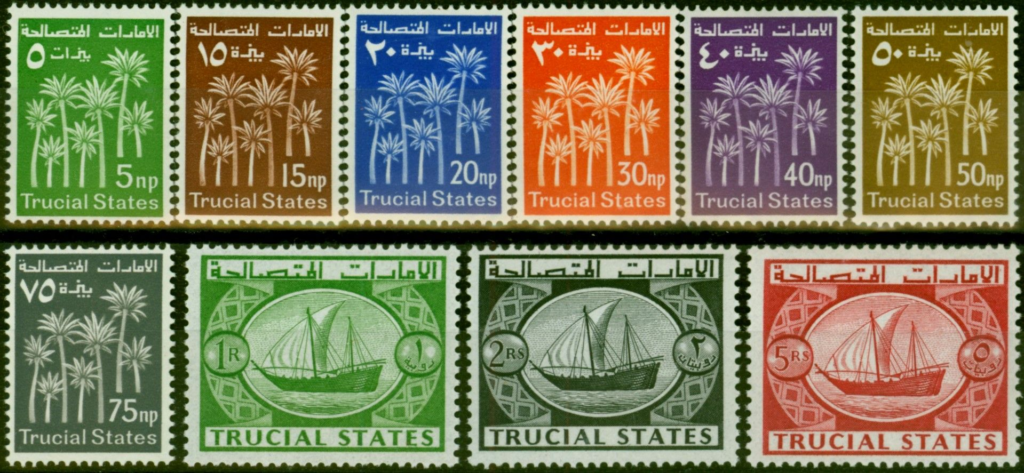The 1961 definitive stamp series of the Trucial States provide a fascinating insight into the postal and political history of the region before the formation of the United Arab Emirates. Issued on January 7, 1961, these stamps were distributed under the administration of the British Postal Agency in Dubai, serving all seven Trucial Sheikhdoms: Abu Dhabi, Ajman/Manama, Dubai, Fujairah, Ras Al Khaimah, Sharjah/Khor Fakkan, and Umm Al Quwain.
Historical Context
The Trucial States, located along the southern shores of the Persian Gulf, operated under a British protectorate from the 19th century until 1971. The protectorate agreements, known as the “Trucial Treaties,” were designed to ensure peace among the coastal emirates and safeguard British maritime interests. By the 1960s, the Trucial States were on the brink of significant political and economic transformation, driven by the discovery of oil and the gradual move towards self-governance.
In this transitional period, postal services in the Trucial States were managed by the British Postal Agency, headquartered in Dubai. The stamps issued during this time symbolized the shared identity and administrative unity of the emirates under British oversight. The 1961 definitive series, valid until September 30, 1963, marks the final chapter of this collective postal history before each emirate began issuing its own stamps. These stamps serve as historical artifacts, reflecting the cultural, economic, and political landscape of the region prior to the establishment of the UAE in 1971.
Design and Details
The series consists of two sets of designs, divided between photogravure and engraved methods of printing. The stamps showcase imagery reflective of the Trucial States’ cultural and natural heritage:
- Palm Trees Design (MiNos. 1–7)
- Values: 5 NP, 15 NP, 20 NP, 30 NP, 40 NP, 50 NP, and 75 NP.
- Printing: Photogravure.
- These stamps depict palm trees, an essential symbol of sustenance and life in the arid Gulf region.
- Dhow Design (MiNos. 8–11)
- Values: 1 R, 2 R, 5 R, and 10 R.
- Printing: Engraved.
- The dhow, a traditional sailing vessel, highlights the maritime heritage and trade significance of the region.
Denominations and Face Values
| MiNo. | Face Value | Description |
|---|---|---|
| 1 | 5 NP green | Palm trees |
| 2 | 15 NP brown | Palm trees |
| 3 | 20 NP ultramarine | Palm trees |
| 4 | 30 NP red-orange | Palm trees |
| 5 | 40 NP violet | Palm trees |
| 6 | 50 NP pale brown | Palm trees |
| 7 | 75 NP grey | Palm trees |
| 8 | 1 R green | Dhow |
| 9 | 2 R black | Dhow |
| 10 | 5 R carmine | Dhow |
| 11 | 10 R grey-ultramarine | Dhow |
Printing and Availability
The stamps were printed in two perforation styles:
- MiNos. 1–7: Perf. C 15:14 (Photogravure).
- MiNos. 8–11: Perf. C 13½:12 (Engraved).
Legacy of the Series
These stamps not only served as essential tools for communication but also as visual representations of the region’s heritage and unity under the British administration. The use of imagery such as palm trees and dhows speak to the historical identity of the Trucial States, emphasizing the importance of agriculture and maritime trade in the region.
After June 14, 1963, the British Postal Agency in Dubai ceased issuing stamps for the entire region, paving the way for individual Sheikhdoms to release their own stamps. Today, this series is a collector’s favourite, offering a snapshot of a pivotal era in the Gulf’s postal and political history.
Closing Thoughts
For philatelists, the 1961 definitive series is a must-have, capturing a unique historical narrative of the Trucial States during a time of shared administration and identity. Whether for its aesthetic appeal or its historical significance, this stamp issue remains a cherished collectible in the world of philately.


